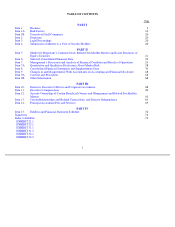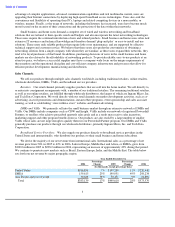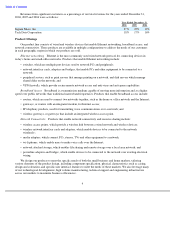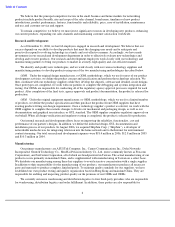Netgear 2006 Annual Report Download - page 15
Download and view the complete annual report
Please find page 15 of the 2006 Netgear annual report below. You can navigate through the pages in the report by either clicking on the pages listed below, or by using the keyword search tool below to find specific information within the annual report.
Table of Contents
As a result, period-to-period comparisons of our operating results may not be meaningful, and you should not
rely on them as an indication of our future performance. In addition, our future operating results may fall below the
expectations of public market analysts or investors. In this event, our stock price could decline significantly.
Some of our competitors have substantially greater resources than we do, and to be competitive we may be
required to lower our prices or increase our advertising expenditures or other expenses, which could result in
reduced margins and loss of market share.
We compete in a rapidly evolving and highly competitive market, and we expect competition to intensify. Our
principal competitors in the small business market include 3Com Corporation, Allied Telesyn International, Dell
Computer Corporation, D-Link Systems, Inc., Hewlett-
Packard Company, the Linksys division of Cisco Systems and
Nortel Networks. Our principal competitors in the home market include Belkin Corporation, D
-Link and the Linksys
division of Cisco Systems. Our principal competitors in the broadband service provider market include AARIS
Group, Inc., Motorola, Inc., Sagem Corporation, Scientific Atlanta, a Cisco company, Terayon Communications
Systems, Inc., Thomson Corporation and 2Wire, Inc. Other current and potential competitors include numerous local
vendors such as Siemens Corporation and AVM in Europe, Corega International SA, Melco, Inc./Buffalo
Technology in Japan and TP-Link in China. Our potential competitors also include consumer electronics vendors
who could integrate networking capabilities into their line of products, and our channel customers who may decide to
offer self-branded networking products. We also face competition from service providers who may bundle a free
networking device with their broadband service offering, which would reduce our sales if we are not the supplier of
choice to those service providers.
Many of our existing and potential competitors have longer operating histories, greater name recognition and
substantially greater financial, technical, sales, marketing and other resources. These competitors may, among other
things, undertake more extensive marketing campaigns, adopt more aggressive pricing policies, obtain more
favorable pricing from suppliers and manufacturers, and exert more influence on the sales channel than we can. We
anticipate that current and potential competitors will also intensify their efforts to penetrate our target markets. These
competitors may have more advanced technology, more extensive distribution channels, stronger brand names,
greater access to shelf space in retail locations, bigger promotional budgets and larger customer bases than we do.
These companies could devote more capital resources to develop, manufacture and market competing products than
we could. If any of these companies are successful in competing against us, our sales could decline, our margins
could be negatively impacted, and we could lose market share, any of which could seriously harm our business and
results of operations.
If we do not effectively manage our sales channel inventory and product mix, we may incur costs associated
with excess inventory, or lose sales from having too few products.
If we are unable to properly monitor, control and manage our sales channel inventory and maintain an
appropriate level and mix of products with our wholesale distributors and within our sales channel, we may incur
11
•
delays in the introduction of new products by us or market acceptance of these products;
• an increase in price protection claims, redemptions of marketing rebates, product warranty returns or
allowance for doubtful accounts;
• operational disruptions, such as transportation delays or failure of our order processing system, particularly if
they occur at the end of a fiscal quarter;
• seasonal patterns of higher sales during the second half of our fiscal year, particularly retail-related sales in
our fourth quarter;
•
delay or failure of our service provider customers to purchase at the volumes that we forecast;
•
foreign currency exchange rate fluctuations in the jurisdictions where we transact sales in local currency;
•
bad debt exposure as we expand into new international markets; and
•
changes in accounting rules, such as recording expenses for employee stock option grants.
























